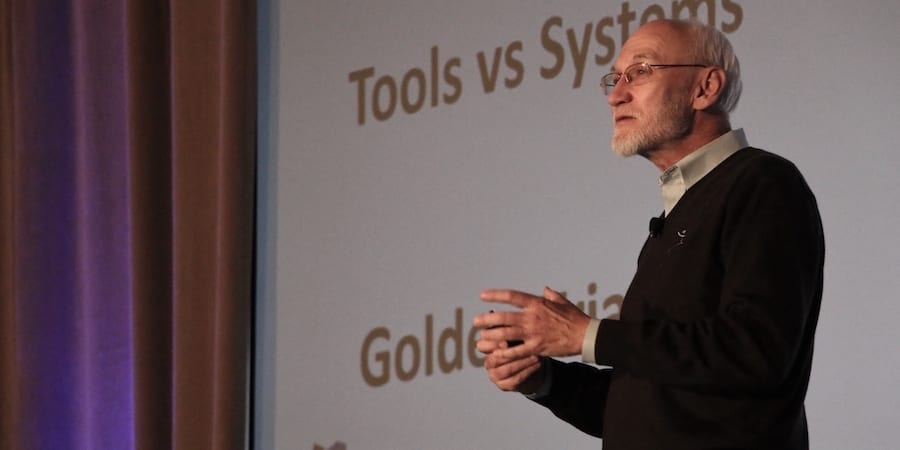
Lean thinking and the challenges it will face
ARTICLE - How can creativity and standards coexist? How do we move beyond silos? How do we fully understand the voice of the customer? Dan Jones reflects on three key questions for the lean movement.
Words: Daniel T. Jones, Chairman, Lean Enterprise Academy
I am often asked to comment on what I see as the future of lean. I have addressed what in my opinion will be the movement’s biggest challenge, learning how to thrive in the so-called ‘digital age,’ in a previous article here on Planet Lean. But the challenges don’t stop there.
I am impressed by the progress lean has made over the past couple of decades: not only has it taught us what respect for people means and given us the tools to improve our processes; it has also helped us to understand what the role of leadership should be in a company that aspires to change.
The methodology has gone in all kinds of directions, extending its reach to most sectors of the economy (granted, more can be done in many of them) and to all layers and functions within organizations, from top management to the front line, from product development to procurement.
But there is much more to do, and lots of questions that remain unanswered.
With this in mind, I would like to discuss three pressing challenges that the lean community must address:
- Clarifying the interaction between standardization and creativity;
- Going past silos and changing the role of experts in organizations;
- Fully understanding the voice of the customer.
CREATIVE, LEAN
Over the centuries, our approach to the knowledge of work has changed substantially – I believe we can identify three main stages of evolution. The earliest one was craftsmanship. Dating back to medieval time, it was characterized by a learning-by-doing approach and by people’s tendency to keep the “secrets” of their work to themselves.
Then came the Industrial Revolution, which took all of those secrets and systematized them, building knowledge of the work into machines. We could call this industrial knowledge
Today, we are in a new phase, which puts an interesting hybrid between technical and social knowledge into the spotlight. This approach allows us to work with others to manage processes (which is what lean ultimately teaches us). It is a bit hard to give it a name, but I think we can call it technical and social mastery. Even better, we can call it organizational mastery.
What we are seeing, however, is that associates in the digital world (IT plays an increasingly important role in our society and businesses) appear to be somehow stuck in the craftsmanship phase. IT professionals tend to feel overprotective with their knowledge and expertise, and seem to favor those approaches that, in their minds, grant them the freedom to be creative and protect them from those who want to treat them like industrial workers. Agile is perhaps the clearest example of this: it was born to give software engineers a place to work “creatively.”
This is where the problem lies for the lean community these days: we cannot afford to go back to craftsmanship, especially in a digital environment (systematizing and standardizing software is necessary to improve it); instead, we must learn how to use technical mastery in a shared context.
One of the main struggles we face as humans is the idea, which we grow up with, that creativity cannot co-exist with standard procedures and codified behaviors. We tend to convince ourselves that rules, any rule really, will destroy our ability to be creative.
The reality is that, as we become masters, we can work together to standardize routine activities and, in doing so, free up time for creativity. Agreeing on a set of guidelines and procedures that can help us make sense of the processes we run will remove the frustration that comes from fire fighting. With it, we will also eliminate the distractions and misunderstandings that take so much of our time, make our work so difficult, and actually pose a threat to our creative drive.
Perhaps the issue lies in the definition of the creativity. To me, creativity means knowing how to combine standard elements into a new solution.
Standards build shared knowledge, and ensure routine activities don’t take too much of our time. They don’t detract from creativity; they enable it.
SILO THINKING IN LEAN
In essence, relying on standards can allow us to harness our people’s creativity in a sustainable way. But in this context knowledge must be seen as an asset shared by everybody involved in a process, which leads me to discuss the second big challenge that lean must overcome: silo thinking is still very prevalent in our companies.
What I often see in multinationals is very smart and talented people trapped in silos, fighting political battles that result in a lot of noise and unnecessary cost.
Instead of allocating resources througha political process, we should find a way to collaborate – within a hoshin process- across vertical silos to improve the value streams. In a siloed organization, functions only work towards the optimization of their own activities, not to improve the business as a whole. We must revisit this, and bring a more holistic view of our organizations to the fore.
Inevitably, in a more holistic, horizontal environment the role of experts would change dramatically. Would categories and functions like lean marketing, lean procurement, lean HR, etc. still be relevant in a scenario in which an organization has a value stream view and no silos? No, they would not.
So how do we focus on the horizontal as opposed of being trapped in the chimneys of the vertical functions? We don’t have an answer to the dilemma yet, but perhaps what we need is a few open-minded multinational organizations who are willing to carry out a few experiments with us to prove the validity of this approach.
THE REAL VOC
The profile of the average 21st century customer changes constantly, and at a very fast pace. If we want to keep up and be successful, we must develop the ability to truly think back from the customer, which is one of the foundations of lean thinking.
It is possibly the hardest thing to do, but understanding and embracing the voice of the customer really is critical to ensuring the future of our businesses.
The lean startup movement, with its quick learning loops and its focus on experiments, has taught us a valuable lesson here: traditional QFD-like analysis is relevant to large projects that take place infrequently, but not to today’s customer expectations. In our world, improvements to products and services are incremental and increasingly based on customer feedback (think of the beta version of a mobile application).
The good news is that our production systems are more flexible than ever (particularly thanks to lean thinking) and have now the ability to quickly adapt to changes. All we have to do is starting a dialogue with our customers.
Take supermarket chain Tesco as an example: the company has several ways to listen to shoppers, from observing store sales to relying on big data and feedback clinics, from having senior management spend a day a week on the floor to setting up a system in which promotions are launched and tested locally (to gather customer feedback) before they are rolled out nationally.
The lean movement has spent a lot of time improving companies’ existing systems and assets. But what if, instead of fixing something that is broken, we could start all over again, this time with the voice of the customer clear in our minds from the beginning? Surely, it would be easier for us to utilize user feedback to fulfill customer requirements.
It is not too late, and a good way to start is educating key customers and turning them into partners with whom we can develop the next generation of products and services. We have a long way to go, but the challenge is definitely exciting.
Dan Jones will deliver a talk on how to involve users in the development of new lean solutions at the upcoming Lean Summit in the UK (November 17-19; more information here)
THE AUTHOR

The founder and chairman of the Lean Enterprise Academy in the UK, Daniel T. Jones is a senior advisor to the Lean Global Network, a management thought leader, and mentor on applying lean process thinking to every type of business. Together with Jim Womack, he is the author of some of the most influential and popular management books available. A sought-after keynoter, Dan also has organized lean conferences around Europe. He advises organizations in different sectors on their lean transformations, and has experience supporting lean journeys in sectors including construction, manufacturing, supply chain, healthcare.
Read more


FEATURE - With daily management at the heart of its modus operandi, an organization will be able to quickly identify deviation, start solving problems and make strategy deployment a success.


FEATURE – Reflecting on the recently published book by Nate Furuta, the author discusses the role that deep thinking plays in a problem-finding culture and warns us against ready-to-use solutions.


INTERVIEW – In this must-read Q&A, our editor sits down with lean guru John Shook to discuss the meaning of failure, the nature of innovation, and the resilience of our movement.


FEATURE - Can a company be considered lean if its improvement efforts result in layoffs? The author answers this frequently asked question drawing from his own experience dealing with organizations.

